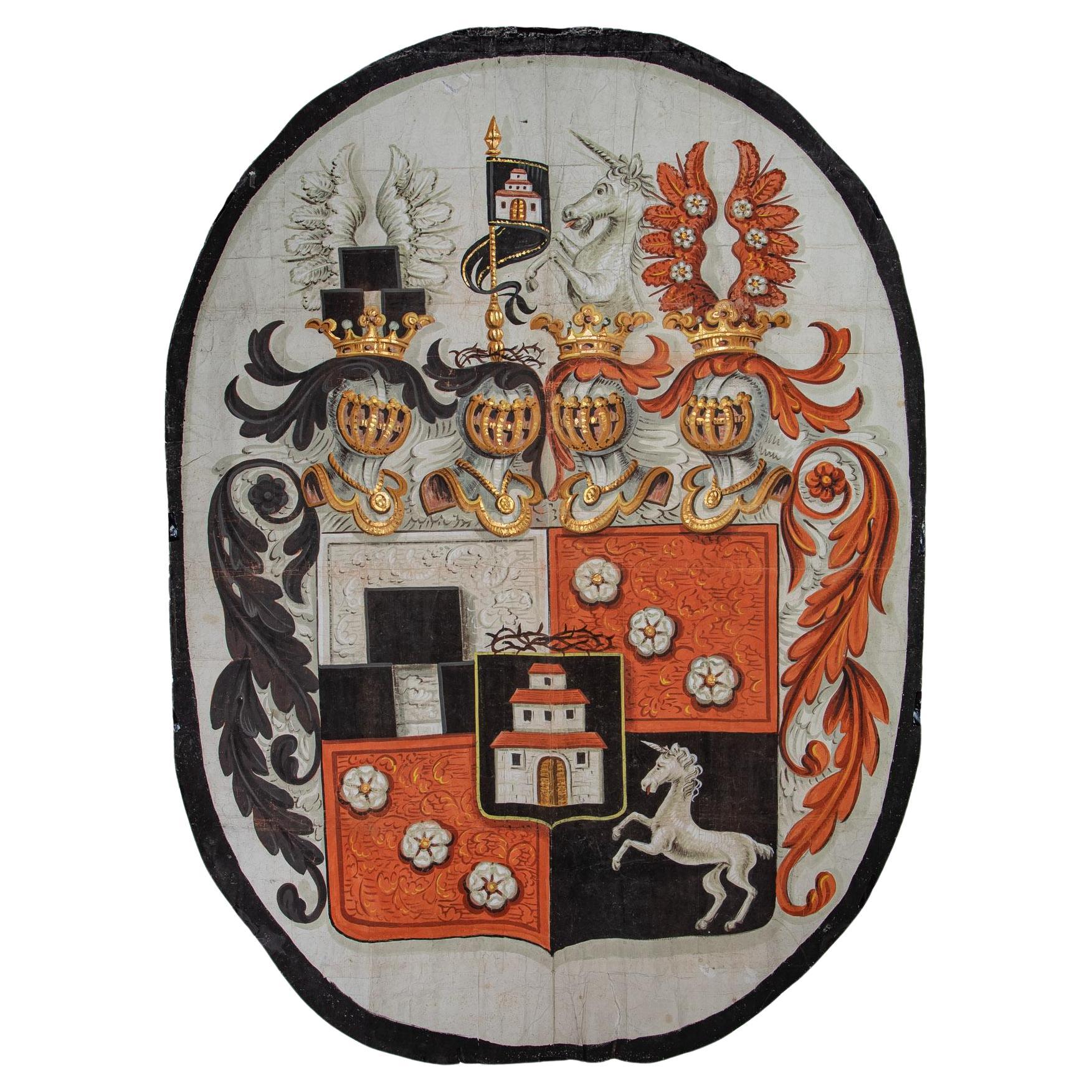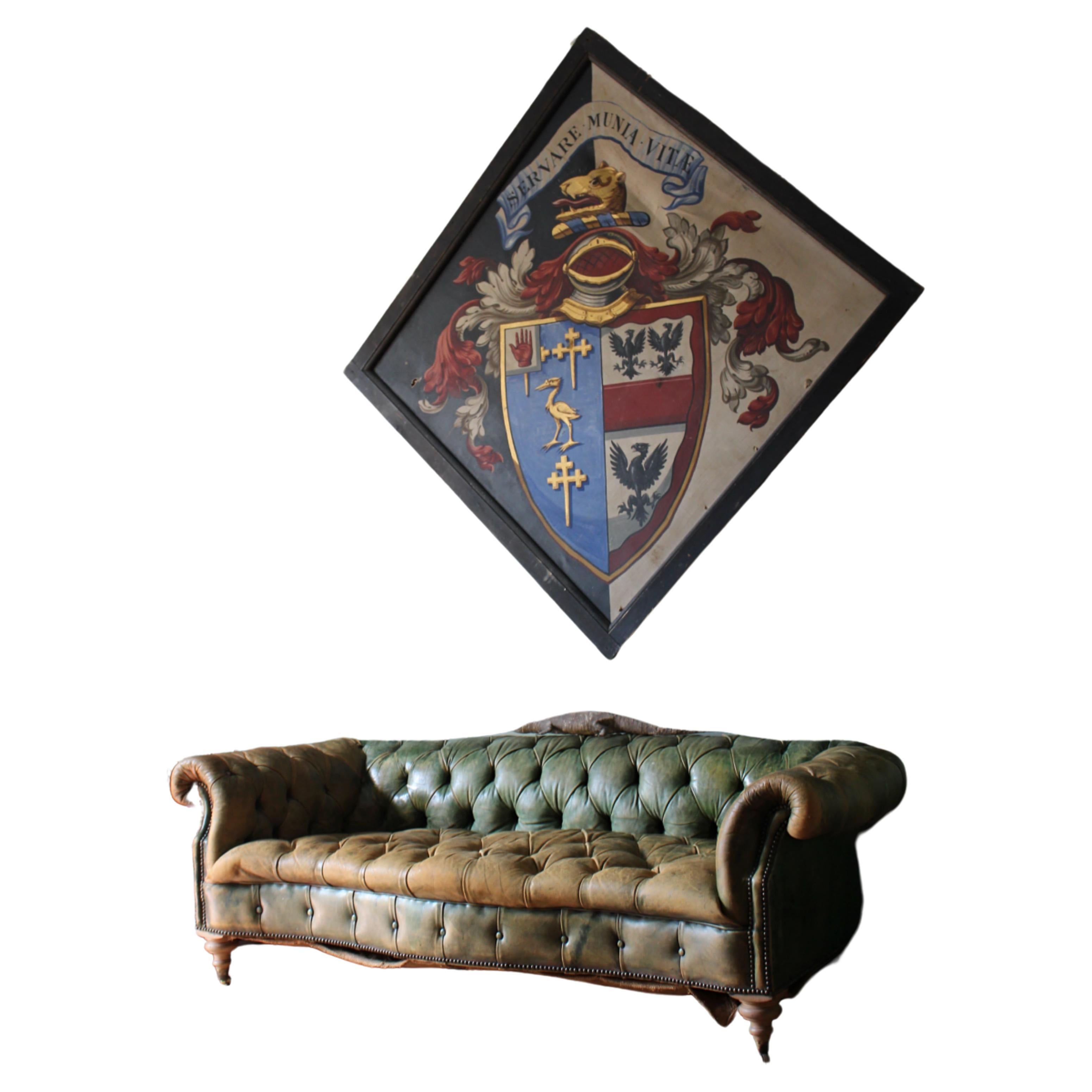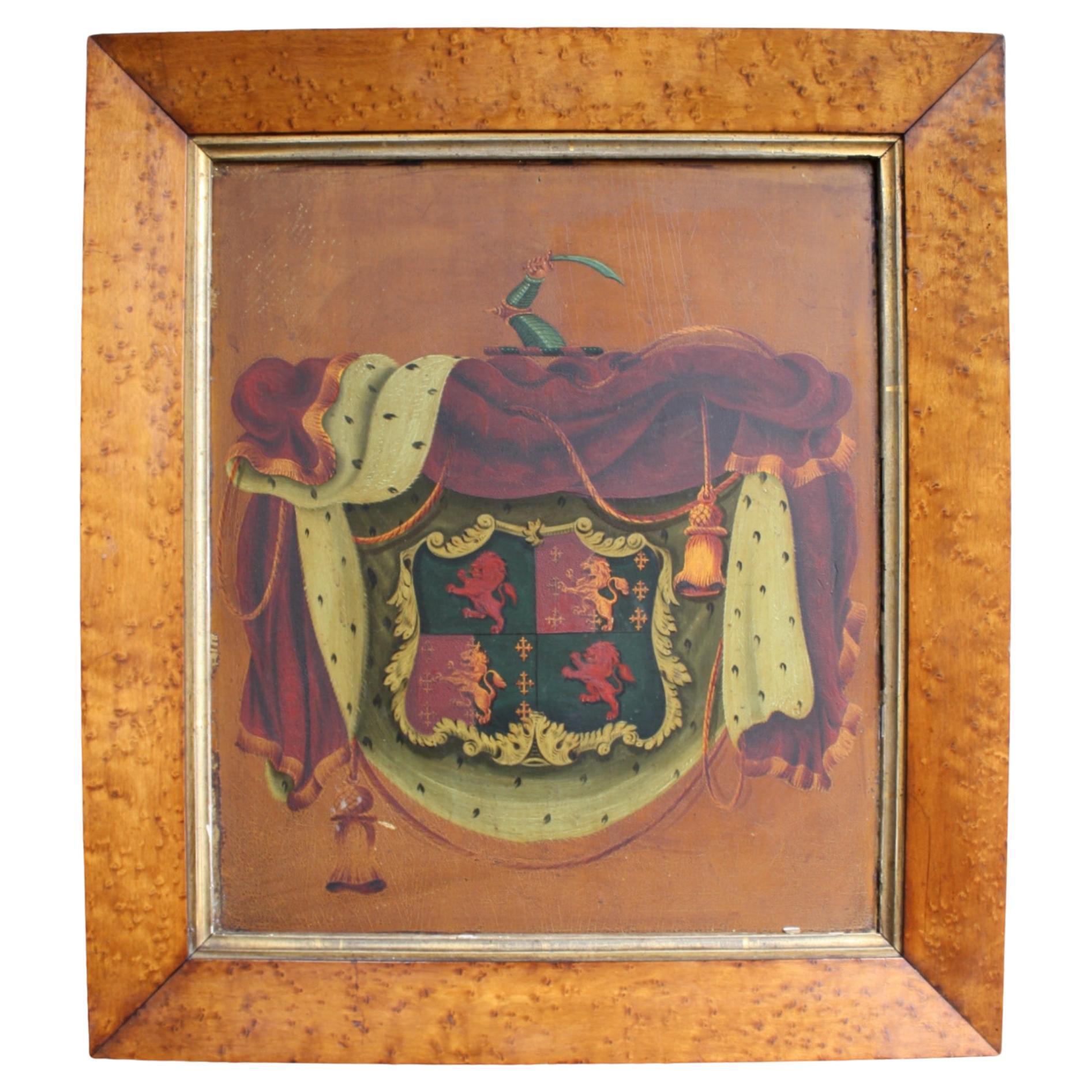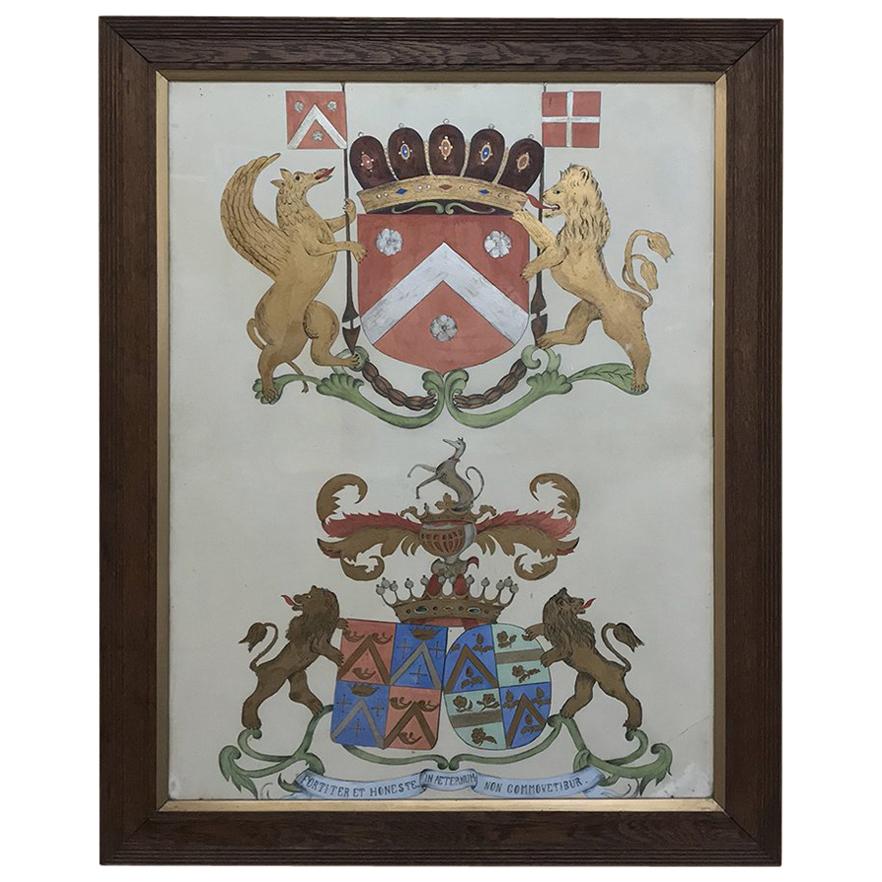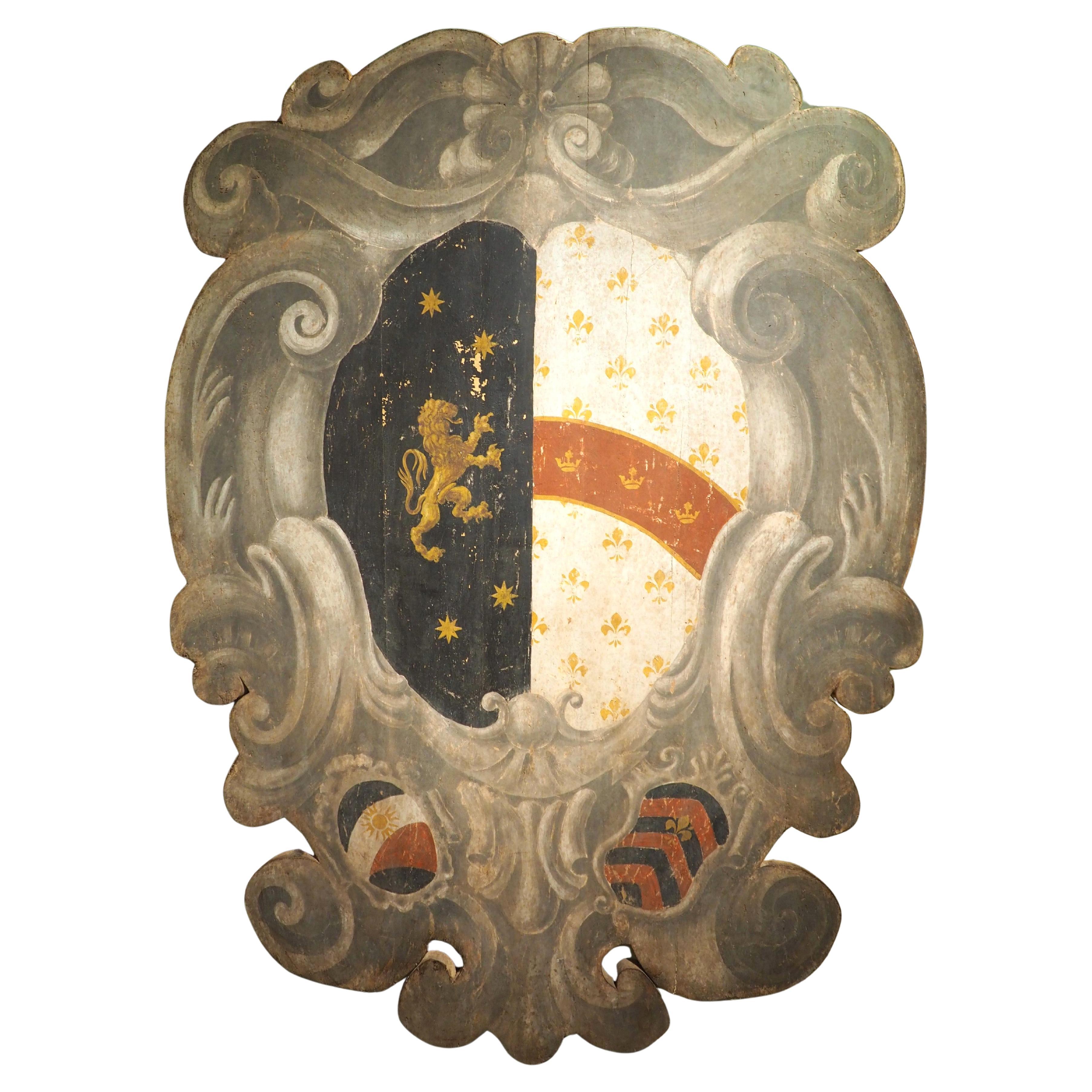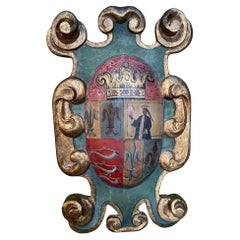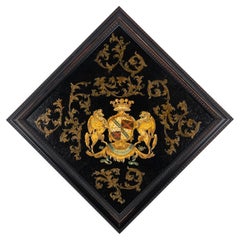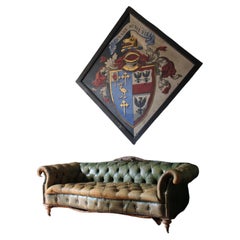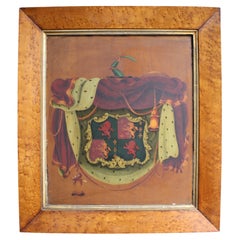Items Similar to 18th Century Oil on Canvas Heraldic Funerary Hatchment Painting
Want more images or videos?
Request additional images or videos from the seller
1 of 12
18th Century Oil on Canvas Heraldic Funerary Hatchment Painting
$7,288.79
£5,295
€6,224.74
CA$10,082.83
A$11,111.98
CHF 5,817.49
MX$136,490.24
NOK 73,098.04
SEK 68,413.95
DKK 46,476.51
About the Item
18th Century Oil on Canvas Heraldic Funerary Hatchment Painting, Memento Mori Painting, Vanitas Skull Painting, Vanitas Painting.
A large high quality 18th Century Oil on Canvas Heraldic Funerary Hatchment Painting, set within a thick ebony and gilt lozenge-diamond shaped frame.
Depicting heraldic coat of arms, bordered by scrolling plumes, topped by a crowned Lion over a Knights armoured helmet, and a skull below the inscription Resurgam at the base.
Very impressive and decorative display piece. Strong colours and detail remain.
Large & imposing scale.
Frame width when hung as a diamond: 178 cm / Frame measured square: 127 cm / Painting: 102 cm square.
A funerary hatchment is a depiction in a lozenge-diamond shaped frame of a deceased’s heraldic achievements, showing the arms, together with the crest and supporters of their family. Regimental Colours and other military or naval emblems are sometimes placed behind the arms of military or naval officers. Such funerary hatchments would therefore generally be restricted in use to members of the nobility or armigerous gentry, and were hung on the wall of a deceased person's house. They were later transferred to the parish church, often within the family chapel therein which appertained to the manor house; the lord of the manor usually held the advowson of the church.
The practice developed in the early 17th century from the custom of carrying an heraldic shield before the coffin of the deceased, then leaving it for display in the church. In the 17th century the hatchments were sober black lozenge-shaped frames with the coat of arms. In the 18th century both the frames and the heraldry got more and more elaborate. Symbols of death like batwings, skulls, hour-glasses and crying angels with torches were added and the names of the forebears.
Funerary hatchments were used in England, Scotland, and also Belgium and the Netherlands where they were described as Mourning Shields. The interest in hatchments lies in the background as well as the Coat of Arms, for the colour of the former will determine whether the deceased was a widower or a widow. The background will vary from all black to black and white halves. The custom developed for impaled arms that when the spouse was still living the background behind their half of the shield would be rendered white, as distinct from the black background of deceased person.
The image of the skull also links this Funerary Hatchment to Vanitas or Memento Mori paintings. Vanitas (Latin for 'vanity') is a genre of art which uses symbolism to show the transience of life, the futility of pleasure, and the certainty of death, and thus the vanity of ambition and all worldly desires. Vanitas art is a type of allegorical art representing a higher ideal. Memento mori is a similar theme which when translated from Latin means, "remember that you will die."
Due to large scale would ship to UK and Europe via van courier. Worldwide shipping also possible. Message for a quote.
Free collection from London SE18 by appointment.
- Dimensions:Height: 50.01 in (127 cm)Width: 50.01 in (127 cm)Depth: 1.19 in (3 cm)
- Style:Gothic (Of the Period)
- Materials and Techniques:
- Place of Origin:
- Period:
- Date of Manufacture:Circa 1730 - 1770
- Condition:Wear consistent with age and use.
- Seller Location:London, GB
- Reference Number:1stDibs: LU10296244907022
About the Seller
No Reviews Yet
Vetted Professional Seller
Every seller passes strict standards for authenticity and reliability
1stDibs seller since 2025
- ShippingRetrieving quote...Shipping from: London, United Kingdom
- Return Policy
Authenticity Guarantee
In the unlikely event there’s an issue with an item’s authenticity, contact us within 1 year for a full refund. DetailsMoney-Back Guarantee
If your item is not as described, is damaged in transit, or does not arrive, contact us within 7 days for a full refund. Details24-Hour Cancellation
You have a 24-hour grace period in which to reconsider your purchase, with no questions asked.Vetted Professional Sellers
Our world-class sellers must adhere to strict standards for service and quality, maintaining the integrity of our listings.Price-Match Guarantee
If you find that a seller listed the same item for a lower price elsewhere, we’ll match it.Trusted Global Delivery
Our best-in-class carrier network provides specialized shipping options worldwide, including custom delivery.More From This Seller
View All18th Century Carved Gilt & Polychromed Armorial Coat of Arms Cartouche Plaque
Located in London, GB
Armorial Coat of Arms Wall Plaque, Antique Coat of Arms, Carved Coat of Arms Wall Sculpture, Coat of Arms Oil Painting, 18th Century Coat of Arms Cartouche.
Unusual mid 18th Centur...
Category
Antique Mid-18th Century French Rococo Wall-mounted Sculptures
Materials
Wood, Paint
19th Century Italian Religious Icon Oil Painting in Gothic Revival Cabinet Frame
Located in London, GB
Antique Religious Oil Painting, Antique Religious Icon, Antique Gothic Revival Religious Painting, Antique Gothic Revival Cabinet, Reli...
Category
Antique 1890s Italian Gothic Revival Paintings
Materials
Copper
19th Century Carved Dummy Board Oil Painting of an Angel & Crown of Thorns
Located in London, GB
Antique Angel Painting, Religious Angel Painting, Antique Angel Sculpture, Antique Dummy Board, Antique Religious Painting, Antique Religious Sculpture, Gothic Antique.
19th Century Religious Dummy Board Oil Painting of Angel...
Category
Antique 19th Century German Gothic Figurative Sculptures
Materials
Wood, Paint
Early 19th Century French School Vanitas Still Life Oil Painting on Canvas
Located in London, GB
Antique Vanitas Oil Painting, Antique Memento Mori Oil Painting, Antique Skull Oil Painting, Gothic Antique Painting, 19th Century Vanitas Still Life Oil Painting.
Early 19th Century French Vanitas Oil Painting on Canvas.
The Old Master Vanitas Still Life Painting depicts a skull, book and rosary.
Oil on canvas, lined. Unsigned.
In gold gilt period frame.
Very well painted, attractive & highly decorative Vanitas skull...
Category
Antique Early 19th Century French Gothic Paintings
Materials
Canvas, Wood, Giltwood, Paint
18th Century Spanish Colonial Mater Dolorosa (Our Lady of Sorrows) Oil Painting
Located in London, GB
18th Century Mater Dolorosa Religious Oil Painting, Antique Spanish Colonial Religious Oil Painting, Our Lady of Sorrows Painting, Antique Religious Oil Painting...
Category
Antique Late 18th Century Mexican Spanish Colonial Paintings
Materials
Copper
16th Century Oil Painting of Emperor Frederic III by School of Hans Burgkmair
Located in London, GB
16th Century Oil Painting of Holy Roman Emperor Frederic III, Antique Religious Oil Painting, Antique Royal King Oil Painting, Hans Burgkmair the older.
16th Century Oil Painting on board of the Holy Roman Emperor Frederic III by circle or school of Hans Burgkmair the older (1473 - 1531).
Portrait of the Holy Roman Emperor Frederic III. (1415 – 1493).
Oil on wooden panel. Described top right.
In later attractive European gilt frame with black & gilt inner decoration, circa 18th Century.
Hans Burgkmair was a German woodcut...
Category
Antique 16th Century German Renaissance Paintings
Materials
Wood, Paint
You May Also Like
An Impressive 18th Century Painted Parchment Armorial
Located in ARMADALE, VIC
An Impressive 18th Century Painted Parchment Armorial
Height: 260cm Width: 185cm
Provenance: Private Melbourne collection.
Category
Antique 18th Century Italian Medieval Paintings
Materials
Parchment Paper
Victorian decoupage armorial hatchment, 1800's
Located in Kenilworth, IL
Victorian decoupage hatchment created from an early 19th century published source of armorial crests. Coat of arms with Rickford family motto “Virtute Non Verbis," which translates t...
Category
Antique 19th Century British Wall-mounted Sculptures
Materials
Wood
19th Century Funerary Funeral Hatchment Sir Henry Oglander Memento Mori Curio
Located in Lowestoft, GB
19th Century Funerary Hatchment for Sir Henry Oglander, 7th Baronet of Nunwell
Azure ground shows, a stork between three cross-croslets fitchee or,...
Category
Antique 19th Century English Historical Memorabilia
Materials
Canvas, Pine
Large English Country House 19thC Oil on Board Armorial Coat of Arms Coach Panel
Located in Lowestoft, GB
An early 19th century
coach panel, larger than the norm, oil on board of an armorial centred by a typical shield, drapes and a warriors arm holding a s...
Category
Antique 19th Century English Paintings
Materials
Hardwood
19th Century Framed Hand Painted Painting of Family Crests
Located in Dallas, TX
19th century framed painting of family crests was hand-painted in the late 19th century and framed in the 20th century. The artist used ink and wat...
Category
Antique 1880s French Renaissance Revival Paintings
Materials
Paper
Large Scale Carved and Painted Italian Coat of Arms Panel from Florence, H-78.5
Located in Dallas, TX
Constructed from salvaged antique wood that has been reinforced with more recent boards, this large-scale coat of arms shield has an outward curve, reminiscent of the bend of a real ...
Category
21st Century and Contemporary Italian Paintings
Materials
Wood, Paint
